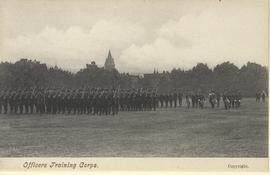The personal papers of Colin Murray from after he left Westminster School. Including documents regarding the Westminster School Society, the Elizabethan Club, the War Memorial Appeal, Quatercentenary celebrations, commemoration services, correspondence, press cuttings and Christmas cards.
Pen and watercolour drawing of man in classical clothing. An annotation at the foot of the drawing reads 'Old Man: Tunic of Pallium.' Possibly a design drawing for the 'authentic' costumes introduced by Head Master Richard Williamson's from 1839.
Black necktie with brown and light blue stripes. Manufactured by P.L. Sells.
Glass Plate Negatives (4¼” x 3¼”). [missing] original box no. "V.C. 2"
One copy annotated on reverse by R.S. Chalk, as follows:
'Memories 1918-1924
This is presumably Inspection up Fields in days before World War I. Such an annual Inspection, even after that War was an impressive affair- conducted by this or that distinguished O.W. soldier. The Band (I remember) played Handle’s March from ‘Scipio’, on each occasion.
By the end of the War, the Q.T.C. (invariably referred to as “The Corps”) was all-important in School life. I suppose 80% of boys were in uniform all days of the week - the majority of the remainder waiting till their uniforms arrived. Few senior boys had School uniform, and the sudden announcement in Lent 1919 (after the Armistice) that all must wear Etons or tails from next Term caused panic.
Unless exempted on medical grounds, it was quite exceptional for anyone not to be in the Corps. Nor without reason - all were due to be called up at 18. It was not unusual for a boy to leave School then be at the Front by the end of that year - in some cases, not to return.
The School’s War Record was a very fine one, not least as the result of high standards in the Corps - 220 names on the War Memorial, I believe - and each trained as an Officer before leaving School.
Numbers in the Corps declined in years after the War, but high standards continued. K.SS in particular took Corps very seriously.'
